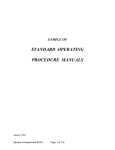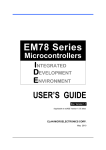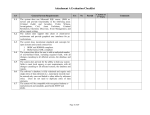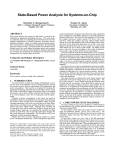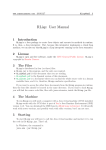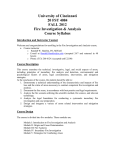Download A Framework for Interacting Design/CPN-and Java
Transcript
A Framework for Interacting Design/CPN- and Java-Processes Olaf Kummer Daniel Moldt Frank Wienberg Universitat Hamburg, Fachbereich Informatik Vogt-Kolln-Strae 30, D-22527 Hamburg fkummer, moldt, [email protected] Abstract In order to widen the applicability of Design/CPN for the specication and design of large scale distributed applications, a framework has been developed that supports the interaction of Design/CPN and Java processes. Thereby a seamless embedding of the two worlds of Petri nets and object-oriented programming is achieved, allowing problem oriented modeling at dierent abstraction levels in a fully distributed environment. The general possibilities to connect Design/CPN with remote processes are discussed and a specic implementation of the required framework is sketched. Promising application areas are named and for some of them concrete example models are provided. Keywords: Coloured Petri Nets, Design/CPN, Distributed Simulation, Framework, Java, Modeling, Prototyping 1 Introduction The specication of systems, its evaluation, and its transfer to implementation is still a major task for computer science. One very promising technique in the area of specication, especially when concurrent and distributed systems are involved, are Coloured Petri Nets (see [5]). Because a strong interconnection of specication and implementation is very useful when developing a system, it is desirable to bring together the worlds of Coloured Petri Nets and some popular programming language. In the area of implementation Java (see [4]) aroused special interest for building applications for the Internet, as it is an object-oriented, reasonably portable programming language that supports additional features such as high-level networking and easy multithread programming. As a specication tool based on Petri nets, we chose Design/CPN (see [2] and [7]), because it is exible and powerful and comes with a specially adapted graphical editor. Design/CPN supports the development of large systems by means of hierarchical models. In this setting, Java should be used for the implementation of graphical user interfaces, database connectivity, and other applications for which one can fall back upon reusable implementations, while Design/CPN serves as the graphical specication tool that is powerful in designing and executing models of concurrent, distributed systems. But there are more reasons why an interaction of Design/CPN and Java has been expected and indeed turned out to be fruitful, namely to overcome some limitations of Design/CPN: The tool is designed for single-user mode only, but especially large-scale projects are dependent on group- or teamwork. Although there is a exible hierarchy concept, Design/CPN does not really support component re-use, as the exchange of parts between dierent models is dicult. In the simulator, interfaces for calling programs implemented in languages other than ML are supported on a very low level only. Although the tool itself, 1 especially with the extension Mimic (see [11]), oers graphical user interface routines, these are also very rudimentary compared to state-of-the-art tools. Last but not least the process of implementing a system that has been designed with Design/CPN is not well supported by the tool. Since there is no way to execute a Design/CPN model in a stand-alone fashion and also simulation of large-scale models is not quite as ecient as a (compiled) program, it would at least be desirable to provide a step-wise migration of the system from net models to some programming language. Motivated by all these considerations, a framework has been designed that establishes new possible elds of application where Design/CPN may be employed. The framework extends Design/CPN in several ways: Distributed simulation is achieved by dierent technical means, namely sockets and pipes. The implemented architecture and alternative concepts for the interconnection of multiple Design/CPN processes are described in section 2. In section 3 it is shown how Design/CPN can communicate with Java processes during simulation. This allows invoking Java methods and even the creation of Java objects. Section 4 explains the reverse communication direction where Design/CPN processes are invoked by Java, viewing the whole Design/CPN process as an object. Possible applications of the extensions and benets gained from them are discussed in section 5. Section 6 provides an outlook on how the framework can be extended further and how it can be exploited for other approaches. 2 Distributed Design/CPN Processes If we want to achieve a distributed simulation using Design/CPN, we have to run multiple instances of the program and allow synchronization of the multiple nets that are being executed. Design/CPN is a well suited for this task, because it can be customized conveniently, using an extended version of ML as internal programming language. 2.1 Possible Communication Channels Running multiple instances of Design/CPN while simulating a single Petri net requires communication and synchronization. Since shared memory is not provided, we have to use some form of message passing. Whatever I/O-channel is used, a blocking I/O call will stop the current net simulation, because the simulator is strictly single threaded. Hence it is usually not advisable to perform blocking I/O, although this might be an option in some cases. Instead, we have to do polling I/O, checking for new input from time to time. There are essentially three possibilities to send and receive messages from within a Design/CPN simulation process: Ordinary les. One Design/CPN process might write to a le, while another process might read the le. This is an inecient method, especially if the processes access a le by NFS. Almost all network le systems cache le contents so that a change does not immediately propagate through the whole network. This makes ordinary les practically worthless for communication purposes. TCP connections. A TCP connection involves a server and a client. The server will setup a server socket under a well-known port number, so that it can accept an arbitrary number of connections from clients. Each server socket is identied by the port number and the server's host at the time the client socket is created. 2 communication server TCP the Net TCP communication server TCP Design/CPN TCP Design/CPN the Net TCP Figure 1: Server solution the Net TCP TCP communication subprocess pipes communication subprocess pipes Design/CPN Design/CPN TCP messenger subprocess pipes messenger subprocess pipes Design/CPN Design/CPN Figure 2: Messenger solution Figure 3: Fully distributed solution Using the ML-library SysIO Design/CPN supports client sockets with the help of low-level le descriptor I/O. Pipes. It is possible to generate an external process on the same machine by means of the execute function. The call will provide input and output pipes from Design/CPN to the created process. These can be handled by the usual ML stream I/O library, which is signicantly easier to use than the raw le I/O. Of course, after a few routines have been written to handle the interprocess communication, the designer of a model does not get into contact with these routines very often anyway. This approach is suggested in the process example that is distributed with Design/CPN 3.02 which starts a Tcl/Tk process as an example. One the one hand, pipes are most useful when we want to communicate with other processes on the local machine that can be started during the simulation. On the other hand, the more versatile TCP connections have to be used if the processes is required to run on dierent machines or to be started before the net simulator. 2.2 Possible Communication Architectures The process started by an execute could of course be another Design/CPN process, but a Design/CPN simulation cannot access its own standard input and output streams. Moreover, at present there is no way to start a simulation automatically within a Design/CPN process with which we could interact. These two diculties practically rule out direct pipe communication between the two nets. Moreover, we cannot use direct TCP communication, because it is not possible to implement server sockets within Design/CPN. This leaves us with three basic options: 3 One dedicated communication process is started (the communication server). It opens a server socket that can be accessed by an arbitrary number of Design/CPN processes with one TCP connection each. For a visualization of this architecture see Fig. 1. Every Design/CPN process starts a messenger subprocess and accesses it via pipes. The messenger subprocesses is responsible for transporting the messages to and from the server. It will handle the protocol with the communication server as before (see Fig. 2). Only the subprocesses are present and implement a suitable algorithm for direct message exchange, typically using TCP (see Fig. 3). In principle it would be possible to organize the processes like in Figs. 2 or 3 using TCP connections instead of pipes. However, this would imply programming more dicult ML functions without any obvious benets. Of course the communication processes can be implemented in any language that supports the necessary networking ability, but among the many options the most promising seems to be Java for the reasons given in section 1. The Server Solution In Fig. 1 we can imagine the Design/CPN processes as actors that exchange messages via a mailbox (the server). Each actor has a unique mail address, which may be generated by the system at runtime and which will usually exploit the unique network name of the local computer. Some actors may also be assigned a unique well-known address chosen at programming time. In its simplest form, the mailbox only has to provide commands to send a message to a mail address and to receive a message, if one is available. For performance reasons it may be useful to receive all pending messages. More complex implementations would allow a blocking wait for messages, but this is of little use for a Design/CPN process, since it would suspend the simulation completely. Other options include a forwarding mechanism or a test if a mail address is valid. The host and the port where the mailbox is located must be public for all Design/CPN processes, so that they can establish a connection. The mailbox can quickly become the system's bottleneck, especially because polling access is required on the side of Design/CPN. Nevertheless, this method is surprisingly practical and will perform well provided there are only few processes. The Messenger Solution In this case there is still a mailbox, but every Design/CPN process starts a special messenger process by means of the execute function, as in Fig. 2. The messenger process can communicate with Design/CPN locally, which is usually much faster than remote interaction. Also, since the messenger is only responsible for a single Design/CPN process, we can use a signicantly simpler protocol. Moreover, the messenger can communicate with the mailbox using ecient blocking I/O, thereby taking some load o the bottleneck. Of course, the price to pay is a further indirection leading to some communication overhead. 4 P In input adr; action let val (inf,outf) = execute’(messenger,[adr]); in (infile := inf; outfile := outf) end; P In send STRINGxSTRING (adr,data) adr connect C STRING idle C input (adr,data); action (output(!outfile,"send\n"^adr^"\n"^ data^"\n"); flush_out(!outfile)); connected () VOID VOID P I/O disconnect C VOID P In () C action (output(!outfile, "stop\n"); close_out(!outfile); close_in(!infile)); datams received STRING polling VOID output (datams); action if can_input(!infile) > 0 then 1‘(inputLine(!infile)) else empty; P Out Figure 4: A subpage for string message I/O (IOPage) The Fully Distributed Solution Here we no longer have a central instance; instead each subprocess spawned by Design/CPN interacts directly with other subprocesses. This would lead to further performance benets at the price of a vastly increased complexity of the message-handling algorithm. Even in a fully distributed architecture there might be a kind of centralized name service, which would allow the distributed nets to communicate without knowing the actual location of the other nets. 2.3 A Communication Package We have tried the server solution (in C) and the messenger solution (in Java). Here we are going to limit ourselves to a description of the messenger solution, because it results in a more readable Design/CPN package. The actual implementation of the mailbox and the messenger processes are beyond the scope of this paper. Let it suce to say that much eort went into the handling of concurrency and into the protocol. The actual network programming turned out to be very easy in Java, contrary to C where network calls consitute the majority of the code. At the moment the pure subprocess solution is not implemented, but it could be done in about three weeks, if this is required due to performance reasons. The Design/CPN library, which we are going to describe now, and the protocol on the pipes would not change at all, making an upgrade possible without any problems and in fact without any noticeable dierence for the users. All basic message handling is done on a single I/O page that can be reused in every distributed system of nets, see Fig. 4. It encapsulates all the transitions that set up the connection and send or receive messages. 5 In the communication package described here every Design/CPN process is assigned an arbitrary character string that can be used as the mailbox address. The I/O page is given the mailbox address on which it will listen via the \in" port place connect. The ML variable messenger has to contain the path and name of the executable that starts a messenger process and should be dened in the global declaration node, e.g. val messenger = "/home/cpnuser/bin/messenger"; This path name is not passed as a token, because it does not often change and because an incorrect path might result in errors that are in undetectable in the ML code. Outgoing messages must be put into the \in" port place send in the form of an address/data pair. Both will be handed on to the messenger through the output stream, preceded by the command send. Messages are received from the messenger through the input stream. It is important to test whether there is any pending input with the ML function can input, because input line1 suspends until a newline character (\n) is read. The page provides access to the received messages using the \out" port place received. The data to be sent and received is always a character string. Other datatypes must be converted to a string format, e.g. by using the predened mkst_col'colour functions. Tokens can be put into the polling place or be removed from there in order to either start or stop polling for new messages. Design/CPN only allows to stop an \automatic" simulation run after a given number of steps or in case there are no more enabled transitions. Removing the polling token oers the possibility to stop an automatic simulation run without disconnecting. Furthermore, this feature should be used with nets where it is known when to expect incoming messages, e.g. only as answers to query messages that have been sent before. It is much more ecient not to poll for new messages while the net is working locally and not expecting any message input. If the polling port place is not assigned on the \parent" page, the initial marking of one token will be used and polling will always be activated as long as the connection is up. It should be recalled that Design/CPN uses the initial marking of a port place only if no socket place is assigned to it. Finally, there is a facility to close the connection and shut down the messenger process, because these processes might stay alive when they are not terminated properly. If one wants to do so, one has to change the marking of the disconnect place to one token and re the disconnect transition. Because pipes cannot be uniquely represented as strings, they cannot be used as token colours, hence they have to be stored in reference variables. These are not allowed to be used in arc inscriptions, but in code regions only. We dened two global instance variables, infile and outfile. If one wants to use the subnet more than once, because there is some need to run multiple messenger processes, one can also use instance reference variables which have dierent values for each page instance. This may be desired when many net fragments are developed and tested within one simulator, before they are nally split into many independent nets. The reason why we used global reference variables is that we normally do not use more than one instance of the I/O page and also that instance variables cannot be reached from ML code via Design/CPN's ML evaluate feature, e.g. to close the streams manually. 1 The function inputLine used here is just a customized version of input line that cuts o the newline at the end of the result string. 6 3 Accessing Java from Design/CPN It should be clear that the message passing scheme used in our architecture does not rely on specic Petri net techniques, so that Design/CPN could be complemented by programs in arbitrary languages that support TCP. Again we choose Java as our example language, even though experiments have also been done with C (for details see [1]). A straightforward implementation would provide only the basic routines to send and to receive string messages, leaving the programmer with the task of making the necessary calls. But we can increase the developers' productivity by dening a standard message format, so that we can supply reusable parsing algorithms. On top of that, we can provide algorithms that actually perform the call that was requested by Design/CPN, so that the message passing framework becomes completely invisible to Java programs. Quite the same can be achieved on the side of Design/CPN where we make a Java method call look like an ordinary substitution transition (see section 3.4). 3.1 The Message Format The message format should contain all the necessary information to make a Java method call: the object whose method is invoked, the caller that awaits a return message, the method name for the called Java object, and a list of parameters. We have to distinguish these call messages from another type of messages which we call return messages. A return message is much simpler, as the method name and the caller can be omitted. What remains is just the target object (which is the sender of the call message) and a list of parameters, which in case of Java may only be of length one or zero (if a method is of return type void). One suggestion for a suitable message format that has been implemented has the main aim to keep the net inscriptions and functions simple on the side of Design/CPN. As Design/CPN is based on the functional languages ML, it can handle lists very well. Thus, a message is implemented as a list of the components mentioned above. However, Design/CPN-colours are strongly typed, so a union type of all dierent types that may appear in a message has to be dened. We end up with a message colour denition as follows: color OBJECT = union Null + RC:RCLASS + RI:RINSTANCE + M:METHOD + Int:INTEGER + Str:STRING + Bool:BOOLEAN + Real:REAL; color MSG = list OBJECT; with RC being a colour that represents a reference to a remote class, RI representing a reference to a remote instance, M declaring a method name and Int, Str, Bool and Real being the constructors for the basic datatypes available in ML and Java. Other types, especially arrays, could be added, if desired. This very general message format needs additional constraints for well-formed call and return messages, but oers the advantage to dene both with the same Design/CPN colour. In order to distinguish call and return messages easily, we chose to put the method name in the rst position of the object list instead of using the order of the object-oriented dot notation, where the receiving object is named rst. A message starting with a method 7 name is assumed to be a call message, or else a return message. The complete sequence of a call message is [M(method-name ), invoked-object , caller-object , param1 , param2 , ... ] A return message is simply [receiver-object , result ] where result is optional and the receiver-object is the former caller-object. References are dened as tuples of a class and a process identier the latter of which is used to locate remote objects. Unlike a class reference, an instance reference also contains an ID as a third component that makes the triple a globally unique identier. color RCLASS = product CLASS * PID; color RINSTANCE = product CLASS * PID * RID; These tuples could have been coded into a single string, but using tuples we can apply the built-in Design/CPN pattern matching capabilities to select the information that is needed to send and receive messages. All colours that have not been declared are simply dened as STRING in our implementation. Alternatively, the structure of a message given at the beginning of this section could be directly translated into Design/CPN-colours. For a call message, this would result in a four-tuple of the object being invoked, the method name, the calling object and a list of parameters, which again is a list of objects dened as the message above. 3.2 A Sample Message Communication To illustrate the message format, consider the following Java code fragment: BigInteger bigNum1 = new java.math.BigInteger("42"); BigInteger bigNum2 = bigNum1.pow(42); String bigStr = bigNum2.toString(); Obviously, one call and one return message have to be sent for each statement. When sending messages, we have to provide a unique name for the sender. We can for example use the constant class name cpn, construct the \mailbox" name as hostname :process-ID (of the Design/ML process), and use a sequence number for every sender being active concurrently. Thus, we end up with the rst sender called RI(("cpn","cpnhost:12345","1"))2. At rst, the net has to invoke a constructor method of the class BigInteger. To do so, we also have to provide a mailbox address where a special Java process is waiting for messages (e.g. javaserver) and send a new message like this: [M("new"), RC(("java.math.BigInteger","javaserver")), RI(("cpn","cpnhost:12345","1")), Str("42")] The double brackets appear due to the standard Design/CPN mkst col function which produces a pair of brackets for both the tuple and the union constructor RC. Although most brackets may be omitted in net inscriptions, interactive input, and any other expressions that are evaluated by ML, only this syntax is accepted by the predened Design/CPN function input col used for reading colour values from the input stream. 2 8 The message becomes much easier to read if we replace the objects by CPN variables, which normally is the case in net inscriptions: [M("new"), bigIntegerClass, cpn1, Str("42")] The Java program then performs some actions (which are explained in section 3.6) and answer with a reference to the newly created object: [cpn1, RI(("java.math.BigInteger","javaserver","xyz123"))] Let us call the new object bigNum1. Note that the given reference contains its class, the host (or rather: mailbox name) where it can be reached and some automatically generated ID. Now, we want to compose the message corresponding to the second statement. The net has to invoke the pow method of the given object with the parameter value 42 (this time as an integer). We can reuse cpn1 as the sender, because no other return messages are expected and there is no concurrency involved. [M("pow"), bigNum1, cpn1, Int(42)] Java will answer with a message like [cpn1, RI(("java.math.BigInteger","javaserver","abc456"))] Let us call the given instance bigNum2. Now we convert this number to a string: [M("toString"), bigNum2, cpn1] Note that this method call does not take any parameters. Java responds [cpn1, Str("15013093754529657235677...7970568738777235893533016064")] Have a look at the rst message again, but this time using the alternative message format mentioned in section 3.1: (bigIntegerClass, "new", cpn1, [Str("42")]) The only gain is that we can omit the union constructor M for the method name, but on the other hand, additional brackets appear. Also, we have to dene a dierent colour for return messages. When receiving a message, it normally cannot be anticipated whether it is a call or a return message, so we would have to dene another union colour consisting of call or return messages, which again makes the message format somewhat longwinded. All in all, the perfect message format is partly a matter of taste, but we believe that the list format oers most advantages for Design/CPN. If you want customized net inscriptions, there is also the possibility of dening special colour sets in ML. Using your own string representation, you are no longer dependent on ML syntax. However, this approach takes more time to implement and you still have to tackle the problem of integrating CPN variables into net inscriptions. 9 FG SendReturnMsg FG VOID MSG () SendCallMsg MSG output here; action getUniqueName(); here STRING rcv::msg M(meth)::rcv ::Str(callid) ::msg here C here here (rcv,rcv::msg) sendMsg OBJECTxMSG (rcv, M(meth)::rcv:: RI("cpn",here,callid)::msg) (rcv,msg) (address rcv,mkst_col’MSG msg) send STRINGxSTRING connect STRING FG Polling HS IOPage VOID received FG Disconnect VOID STRING data input_col’MSG(open_string data) M(meth)::msg RI("cpn",here,callid)::msg received M(meth)::msg MSG Str(callid)::msg MSG FG MSG RcvCallMsg FG RcvReturnMsg Figure 5: A message translation page 3.3 A Message Translation Page On top of the message I/O page, another page is built that translates the message to and from the string representation which is used externally (see gure 5). Pages like this one must be created individually according to the input and output types that result from the conversion. The pages are expected to share a common structure, so they can be copied from a standard template and then be modied. Since most of the conversion is done by the predened ML functions mkst_col'colour and input_col'colour , the eort is usually neglegible. In our solution, a unique name for connecting to the mailbox is generated by a custom ML function getUniqueName() according to the convention described in the previous section. The disconnect socket is transformed to a global fusion place, so that the network 10 P I/O P object P In P I/O control I/O P I/O param1 param2 param3 Void Void Void p1 obj I/O P p2 p3 method FG SendCallMsg meth MSG until_void [M meth,obj,Str callid,p1,p2,p3] callid callid idle wait STRING STRING callid makestring cid callid Str(callid)::msg () cid MSG FG cid+1 RcvReturnMsg if msg<>nil then 1‘(hd msg) else empty 1 FP INTEGER counter control output P P Out Out Figure 6: A subpage wrapping calls to Java methods (Call) connection may be terminated from any page in the diagramm. Access to the send and the receive place are provided via global fusion sets, too. Alternatively, the translation page could have dened port places, so that it could have been used as a subpage to a net that wants to send messages. We chose the former solution because the translation page is expected to be used by several other pages or page instances and it is neither necessary nor desirable to get multiple instances of this page. A single, global page is of course more ecient in simulation runs. 3.4 A Graphical Petri Net Notation for Method Calls A further possibility to avoid complex arc inscriptions and to abstract from the message format is to choose a notation that is more adequate for Petri nets. A (Java) method call always goes through the same steps: The message is constructed from the components mentioned in section 3.1, with a unique identier being constructed as the sender. Then, the message is sent and the caller waits for a return message, which is again decomposed into its components. Figure 6 shows a subpage that implements this behaviour. The interface consists of all components of a call and the corresponding return message. The maximum number of parameters has been chosen to be three in this net but may easily be extended. No practical problems are to be expected, since the maximum of parameters needed can be determined at compile-time and should not be too high, anyway. Moreover, note the distinction between data and control ow: A special place named control indicates the control state of the call, while all other input data is read by test arcs3 only. A unique ID is assigned to 3 In fact, Design/CPN does not support test arcs that do not move any tokens. An arc with no arrows is 11 bigNum1 42 control bigNum1 Int(42) VOID OBJECT Int(42) OBJECT pow "pow" HS METHOD bigNum2 control Call#5 bigNum2->output bigNum1->object 42->param1 pow->method "pow" bigNum2 VOID OBJECT Figure 7: An example of using the Call subpage, illustrating the special graphical notation each instance of the page by using the page instance fusion place counter. Each page instance may only invoke one method at a given time (asserted by the place idle), but several instances of the Call subpage may act concurrently. To handle parameter input, we again take advantage of the Design/CPN feature that the initial marking of a port place is only used if the port place remains unassigned. Thus, all parameter places that are not used by a substitution transition remain Void and are suppressed in the construction of the call message by the ML function until void dened in the global declaration node. The output port place should only be used if the called method actually returns a result, because then the arc expression will produce no token (not even a black one). A separate control token is produced to indicate that the method call is nished. It may be used to enable the next transition. To make the nets calling Java more readable, some Design/CPN regions have been suppressed in the following gures. However, a special graphical notation makes the syntax of the nets clear without ambiguity, as may be seen in gure 7, where the second line of Java code from section 3.2 is shown as a net. The left-hand side contains all regions and inscriptions, while the right-hand side shows how these are translated into graphical representations: All control places and control arcs are shown in bold style. They are always of colour VOID (\black tokens") as they store control information only. Data places and arcs are shown in normal style and all have the colour OBJECT unless they are a method place, which can be recognized by their position directly to the left or to the right to a Call substitution transition. If an arc has no arc inscription, it is either connected to a substitution transition (Design/CPN neglects inscription of such arcs, anyway) or it has the hidden arc inscription () which is one black token. Any transition that invokes an object method, furtherto referred to as an invocation transition, is indicated by the presence of a dotted arc with no arrows. Since all these transitions are substitution transition rened by the Call subpage, the hierarchy substitution region (HS) may be omitted. In order to still state a precise port assignment, the following rules apply: The arc connecting a socket place to the object I/O port is exactly the dotted one. The input and output control sockets can be recognized as the bold places with input and output arcs, respectively. The input parameters are connected with test arcs (no arrows) in normal style. If more than one input parameter is used, the arcs have to be labelled with the parameter index pn (this notation is not needed in this paper). The output port is assigned to the socket that is connected to the substitution transition via an output arc in normal style. treated as an arc with arrows in both directions, thus removing and putting back identical tokens. However, this is not semantically dierent as long as an interleaving semantics is assumed. 12 var s: STRING; () fork Str("42") RC("java.math.BigInteger","tgi3") Str("24") "new" Int(42) bigNumA1 bigNumB1 "multiply" "pow" bigNumA2 bigNumB2 join "add" bigNumC "toString" strNum Str(s) C input s; action DSUI_UserAckMessage s; Figure 8: A Petri net performing concurrent calculations with Java BigIntegers 3.5 An Example Net Calling Java In the following example net some more features of Java-calling Petri nets are illustrated. Why would we take the overhead of constructing a Petri net to call Java methods? Two main reasons are that Petri nets have a graphical representation (thus, we have something like a visual programming front-end for Java) and that they are superior in specifying concurrency. In the example in gure 8, again a computation with big integers is performed, but this time, concurrency is exploited. To specify concurrency, we use transitions to fork and to join control ow. Since both \threads" that are created send messages to Java, we have to take care that the return messages are correctly associated. This is ensured by every instance of the Call subpage using a dierent identier. 13 There have also been other test applications. In [3] a game was developed that simulates a stock exchange using a Coloured Petri Nets. The net was augmented by calls to a graphical user interface programmed in Java, resulting in a game that can be played by multiple players across a network. The new net shows a dramatic increase in usability that would have been impossible with other tools. 3.6 Processing Method Calls in Java We now briey describe how the Java side of our framework treats the incoming messages. As a rst step, a message is converted into an internal representation using a straightforward top-down down-parser. Now some remote references might point to an object of the local Java process. Class references are immediately resolved to ordinary Java classes.4 Then the framework has to translate the remote instance references into local Java objects using a special table of externally known objects. Afterwards the framework determines the class of the invoked object and uses the standard reflection5 package to get a list of all public methods which the object supports. It chooses the appropriate method from the list and calls it in an individual thread. Now other calls can be concurrently received and parsed. After the completion of the method call, the result is sent back to the caller whose address was specied in the message. If a reference to a Java object is returned, the framework generates a unique external name for it and inserts this name in the table of externally known objects. Design/CPN will then receive the message and forward the result. If a Design/CPN process interacts with multiple Java processes, remote references might point to an object of a remote Java process instead of a local Java object. This case, too, is handled by our framework, e.g. one could, if desired, store a reference to an object on one process in a hashtable on another process. There are two possibilities for a CPN process to get to know Java objects. To start with, such an object may be created by a special program that also invokes the framework and inserts the object into the table of externally known objects under a well-known name. Then, the CPN process may access the new method of a class reference. In section 3.2 we have given an example of such a call. In fact, the message looks like a normal method call, which is not the case in the Java programming language, where new is a keyword with a special syntax. To keep the message format clean, we decided to use new like a static method provided by every class instead. This allows the creation of arbitrary Java objects from a Design/CPN net, even for builtin classes like hashtables, windows, etc. Although this device is extremely powerful, a note of caution has to be: The creation of new objects using the new method provides complete access to the Java environment, thereby opening up huge security holes. But Java programs can deliberately reduce their access rights by means of the SecurityManager interface. If this does not prove sucient, it is still possible to protect the access to either the Java framework or to the entire message handling system by passwords or other techniques. Java allows the loading of classes at runtime requiring only a string representation of the class name. Even the creation of classes at runtime is possible. 5 The reflection mechanism is a powerful feature of the Java environment that allows the complete analysis of objects, classes and methods at runtime. Thus, Java programs can view a reected image of themselves as if in a mirror. Additionally, the modication, the creation, and the invocation of objects is supported. 4 14 FG RcvCallMsg MSG method METHOD P M(meth)::rcv::snd::msg I/O meth "" input msg; output(p1,p2,p3); action let val msg’=msg ^^ [Void,Void,Void] in (nth(msg’,0),nth(msg’,1),nth(msg’,2)) end; C snd p1 p2 control sender param1 P Out idle () VOID P VOID OBJECT control OBJECT P In VOID out Out p3 param2 param3 P Out OBJECT P Out OBJECT output Void P In OBJECT if out=Void then 1‘Void else empty snd snd::(if out=Void then nil else [out]) FP FG SendReturnMsg MSG Activate FG Polling () VOID VOID Figure 9: A subpage for calls to a CPN (CPNCall) 4 Accessing Design/CPN from Java In the last section, we have shown how to call Java from Design/CPN. This approach is useful when the major part of the application is modeled with Design/CPN and Java is used to complement the application. In other cases, an application or at least large parts may have already been implemented in Java, but Petri nets are utilized for modelling use cases or workows that are contained in the application. Then, one may wish to design and run these parts with Design/CPN and call Petri nets from Java. The basic idea is that a system modeler can use the most appropriate tool for representing and solving the problem at hand. All one has to do to extend our approach to support this feature, is rstly to implement generic Java proxy objects that call Design/CPN nets via messages. Secondly, Design/CPN nets have to be extended to be able to receive and process call messages, not only return messages. In a sense, a Design/CPN process has to behave like a single (static) object, thus providing some methods that may be called. 4.1 Designing a Subpage for Calls to Design/CPN Nets Again, we have tried to nd a very general solution, i.e. a net subpage that can be re-used for any Design/CPN net implementing some method call. Figure 9 shows such a subpage which is basically the counterpart to the net presented in gure 6. The two transitions at the bottom ensure that the net is able to receive messages all the time, in contrast to a net that just calls Java methods and polls for return messages if some call has been sent. 15 The upper transition checks all incoming messages whether they are call messages to the method name given in the port place method. If so, the parameters contained in the call message are distributed into separate places (again, the maximum number of parameters is restricted to three) and a token is put into the control output port place to specify that the \parent" net may start now. The receiver of the message is ignored, because the whole net is treated like a single object. If this net had not been the receiver of the message, the message would not have been delivered there. The idle place is needed because this simple version of calling a net does not support concurrent calls to the same net, while it does allow concurrency within the net. This restriction is lifted when our object Petri net approach is used as discussed in the conclusion. After the parent net has nished its task, it has to put a token into the control input port place. It should remove all input parameter tokens as well as all tokens that were produced during the run, lest the next call fails or produces unexpected results.6 When a socket place is assigned to the output place, some token has to be present that is used as a return parameter. The subpage then constructs a return message to the sender of the call message and puts it into the global fusion place SendReturnMsg, so that it is sent by the Message page and the IOPage. 4.2 An Example of a Net that can be Called To illustrate the use of this subpage, we specify a net that implements a method executing some example workow by W. v.d. Aalst, cited in [12]. The example was introduced as follows. When a criminal oence happens and the police has a suspect, a record is made by an ocial. This is printed and sent to the secretary of the Justice Department. Extra information about the history of the suspect and some data from the local government are supplied and completed by a second ocial. Meanwhile the information on the ocial record is veried by a secretary. When these activities are completed, a prosecutor determines whether the suspect is summoned or charged, or whether the case is suspended. In gure 10, a workow for this case is modeled using our object-oriented Petri net notation introduced in section 3.4, extended by the feature that an invocation transition may consume input parameters. In the upper part, the interface places of the method crimeCase are connected to the subpage CPNCall through a substitution transition. The arcs that point to the bottom border of the gure are actually connected to this transition, too. Note that tokens for the places official1, official2, secretary, and prosecutor have to be provided elsewhere. We do not give any further details on how the invocation transitions might be rened. In fact, the activities may be implemented as code regions, as subpages, in Java or even as other nets that may be called through the message interface. In this case the call of the workow from Java simply looks like RemoteCPN cpn=new RemoteCPN("cpnhost:12345"); String decision=(String)cpn.execute("crimeCase","Roger Rabbit", "murder of Marvin Acme"); assuming that cpnhost:12345 is the hostname / process-ID of the Design/ML process (and thus its mailbox name) simulating the workow net, that the suspect is Roger Rabbit, and that he is accused of murder, where the decision of the prosecutor (as well as the input parameters) is implemented as a String. 6 It is not too complicated to check this property automatically using state invariants. 16 method "crimeCase" HS CPNCall p2 p1 official1 suspect offence "record" record send secretary official2 record record "verify" "complete" recordOK Bool true collect prosecutor updatedRecord "decide" decision Figure 10: An example of a net that can be called from Java 5 Possible Applications and Benets Petri nets are already a concurrent formalism, so a net model documents the intended concurrency without the need to distribute it. But there remain at least two cases where a distributed net model is favourable even in the absence of interaction with Java: Need for performance gains. Whether any signicant performance improvements are possible depends on several factors. It must be possible to split the application into parts that communicate by messages. This is often naturally the case, but existing net models might not show the possible splitting lines clearly. What is more important is that the nets should require as little communication messages as possible. Alternatively, the net might be demanding in terms of ML evaluation time, e.g. animation or optimization algorithms. In both cases, the communication cost might be dominated by the computation cost. 17 Real concurrency. The Design/CPN simulator is a single-threaded application. Thus, no real concurrency, not even multi-threading is available. Multi-threading would be especially desirable if complex or time-consuming ML-functions are executed, which is normally done within one simulation step, delaying all transitions. Now, code may be moved to a separate diagramm (or any external programm, see below), enabling the calling net to continue working while the computation is performed. The drawback of polling for the answer is in some cases preferable compared to blocking the whole simulation. Necessary distribution. Some applications require access to distributed resources, e.g. a visualization module that accesses various screens or a game that needs input from many players. Such applications cannot naturally be realized without a distributed simulator. However, the greatest benet of our communication framework comes from the interoperability with other programming environments: The access to Java processes enables the developer of a net model to incorporate much more complex GUIs into a net. This improves the interaction with the user of the net, but might also be used to animate and visualize the simulated process or to generate more elaborate statistics and debugging information. Although there are some GUI libraries for Design/CPN already|the most notable one being Mimic/CPN described in [11]|they do not match the exibility of Java or comparable languages. Moreover, there is a lack of rapid prototyping tools which greatly speed up the GUI development. Distributed computing also allows multiple users to participate in a single simulation from dierent terminals. Processes that are controlled by Design/CPN might also handle general I/O devices. This may simplify the control OF a system by a net, a possibility already mentioned in the context of the security system presented in section 1.5 of volume 3 of [5]. There it was proposed to extract parts of the ML code generated from the net for the execution on a stand-alone microprocessor. Such a task might be considerably simplied if the connection to the outside world remains the same during the translation. It becomes possible to reuse code that was not developed in Design/CPN or ML. In this area the standard container classes come to mind immediately, but in fact there is a wide range of programs for Java covering almost all aspects of algorithms and data structures as well as various I/O and network libraries. There are additional benets when Coloures Petri Nets can also be called from the outside: It is possible to move gradually from a specication using Petri nets to an implementation using Java. Although this will require that the nets themselves are structured in an object-oriented way, it remains a viable route. The specication of workows with Petri nets has attracted much interest in the past years. Using the framework it seems possible to use Coloured Petri Nets for executable prototypes of workows and in the future maybe even for nal products. 18 6 Outlook The framework presented here improves the usability of Design/CPN in some of the most important areas: distribution, interoperability, appropriate modelling, and graphical user interfaces. A smooth transition from a specication within Design/CPN via distributed Design/CPN modules to distributed Java modules seems possible. Some applications have already been implemented thereby documenting the gained exibility. In the near future we are going to extend the framework to object-oriented Petri nets in the sense of [6], [9], and [8]. In those approaches the structure of the nets represents most object-oriented features without extensions of Coloured Petri Nets themselves. Tool support of the object-oriented techniques could then further simplify the development process. Additionally, Articial Intelligence concepts as already used in [10] are going to be extended by providing a connection to Prolog. This will allow us to use available tools for logic programming directly from Design/CPN models. Our communication framework already bears some resemblance to other distributed object-oriented architectures. Although many functions and just as many concepts are still missing, it does no longer seem far fetched that Petri nets might one day be usable with systems like CORBA. 7 Acknowledgments Much of the Java implementation described in this paper was done during a project at the University of Hamburg. We would like to thank the participants for their eorts, especially Matthias Ernst, Torben Kroll, Heiko Rolke, and Eberhard Wol. A message passing library in C was implemented by Heinrich Biallas and has been documented in [1]. In [3] Margret Freund-Breuer and Olaf Fricke developed the stock exchange model that was used as a rst test case for our Java interaction framework. References [1] Heinrich Biallas. Realisierung der verteilten Ausfuhrung von gefarbten Petrinetzen. Diplomarbeit, Universitat Hamburg, Fachbereich Informatik, November 1997. [2] Design/CPN Online. WWW page at http://www.daimi.aau.dk/designCPN/. [3] Margret Freund-Breuer and Olaf Fricke. Spezikation mit gefarbten Petri-Netzen am Beispiel des Borsenspiels. Studienarbeit, Fachbereich Informatik, Universitat Hamburg, September 1993. [4] The Java Home Page. WWW page at http://java.sun.com. Contains references to online material as well as to many introductory books and technical papers. [5] Kurt Jensen. Coloured Petri Nets: Basic Concepts, Analysis Methods and Practical Use. EATCS Monographs on Theoretical Computer Science. Springer-Verlag, Berlin, 1992: Vol. 1, 1994: Vol. 2, 1997: Vol. 3. [6] Christoph Maier and Daniel Moldt. Objektorientierte Konzepte { Dargestellt mit gefarbten Petrinetzen. Fachbereichsbericht FBI-HH-M-261/96, Universitat Hamburg, Fachbereich Informatik, August 1996. 19 [7] Meta Software Corporation, Cambridge, MA, USA. Design/CPN Handbook Version 2.0, 1993. [8] Daniel Moldt. Hohere Petrinetze als Grundlage fur Systemspezikationen. Dissertation, Universitat Hamburg, Fachbereich Informatik, August 1996. [9] Daniel Moldt and Christoph Maier. Coloured Object Petri Nets - A Formal Technique for Object Oriented Modelling. In B. Farwer, D. Moldt, and M.-O. Stehr, editors, Petri Nets in System Engineering, Modelling, Verication and Validation, pages 11{ 19, Fachbereich Informatik, Univ. Hamburg, 1997. FBI-HH-B-205/97. [10] Daniel Moldt and Frank Wienberg. Multi-agent-systems based on coloured petri nets. In Pierre Azema and Gianfranco Balbo, editors, Application and Theory of Petri Nets 1997, number 1248 in Lecture Notes in Computer Science, pages 82{101, Berlin, 1997. Springer Verlag. [11] Jens Linneberg Rasmussen and Mejar Singh. Mimic/CPN { A Graphics Animation Utility for Design/CPN. User's Manual Version 1.5. Computer Science Department, Aarhus University, December 1995. [12] Rudiger Valk. On Concurrency in Communicating Object Nets, 1998. Accepted for publication at the International Conference on Application and Theory of Petri Nets (ICATPN). 20




















